5
Section one: The fundamentals
Exercise 1: Notebook Prompt
Many of you are likely familiar with the concept of “ability inequity,” which the authors of this article define as “an unjust or unfair (a) ‘distribution of access to and protection from abilities generated through human interventions’ or (b) ‘judgment of abilities intrinsic to biological structures such as the human body’.”
However, they go on to identify the following “ability concepts” that are less familiar:
1) ability security (one is able to live a decent life with whatever set of abilities one has)
2) ability identity security (to be able to be at ease with ones abilities)
How prevalent are these forms of security among disabled people you know? Or, if you identify as a disabled person, would you say your social surroundings and community foster and support these kinds of security? Furthermore, while the focus of the article is on Kinesiology programs, it is also important to reflect on how academia in general accommodates for disability. If you feel comfortable answering this question, what has been your experience of postsecondary education to date?
-OR-
The authors also observe that “Ableism not only intersects with other forms of oppression, such as racism, sexism, ageism, and classism, but abilities are often used to justify such negative ‘isms’.”
What do you think this means? Provide an example.
| Arora and Wolbring’s article highlights how disability is often ignored in fields like kinesiology, education, and sports, especially when it comes to ensuring people feel secure in their abilities. Their research found that very few studies focus on disability, showing that many kinesiology programs don’t consider how to make physical activity truly inclusive. Without this focus, future professionals might not know how to create programs that allow people with disabilities to fully participate. Instead of supporting people with disabilities, these programs often treat disability as something to be “fixed” instead of accepted.
This issue goes beyond kinesiology—many academic fields don’t fully support students with disabilities. While accommodations are available, they can be hard to access, and students often have to fight for the help they need. Many courses assume all students are able-bodied, requiring in-person attendance, timed exams, and materials that aren’t accessible. This can make students feel out of place, hurting their ability to succeed and their confidence. As Arora and Wolbring argue, schools need to do more than just offer accommodations—they need to create environments where all abilities are valued and supported. This way, academic institutions can be more inclusive and help disabled individuals feel secure in their education and role in society. |
Exercise 2: Implicit Bias Test
Did anything surprise you about the results of the test? Please share if you’re comfortable OR comment on the usefulness of these kinds of tests more generally.
| These tests can be helpful because they make people think about their own beliefs and actions toward disability. Many people don’t realize that ableism isn’t just intentional discrimination; it can also show up in everyday language, attitudes, and behaviors. For example, it might be in how we talk about disability, the assumptions we make, or the way we treat others as “less than” because of their abilities. A test like this can help someone see the small, often overlooked ways ableism exists in society and how they might unknowingly be part of it. It can also highlight unconscious biases or habits that we don’t even notice, which can be important for creating more inclusive and understanding environments. By bringing awareness to these issues, the test can be the first step toward making positive changes in how we think about and treat people with disabilities.
|
B) Keywords
Exercise 3:
Add the keyword you contributed to padlet and briefly (50 words max) explain its importance to you.
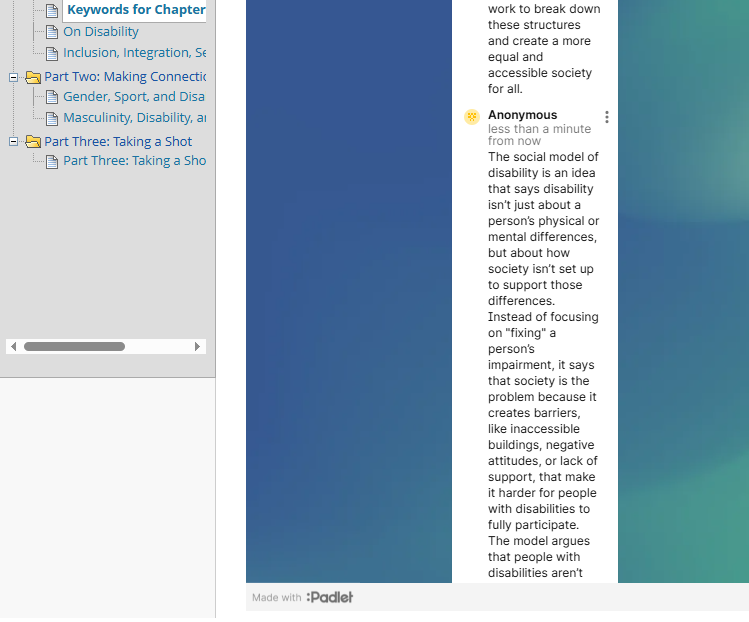
The social model of disability is an idea that says disability isn’t just about a person’s physical or mental differences, but about how society isn’t set up to support those differences. Instead of focusing on “fixing” a person’s impairment, it says that society is the problem because it creates barriers, like inaccessible buildings, negative attitudes, or lack of support, that make it harder for people with disabilities to fully participate. The model argues that people with disabilities aren’t disabled just because of their condition, but because of the way society is built. The social model pushes for changes that make society more inclusive—like better accessibility, more supportive attitudes, and policies that help people with disabilities live full lives. It also emphasizes the importance of listening to people with disabilities since they know best what they need to live well in society.
|
B) On Disability
Exercise 4: Complete the Activities
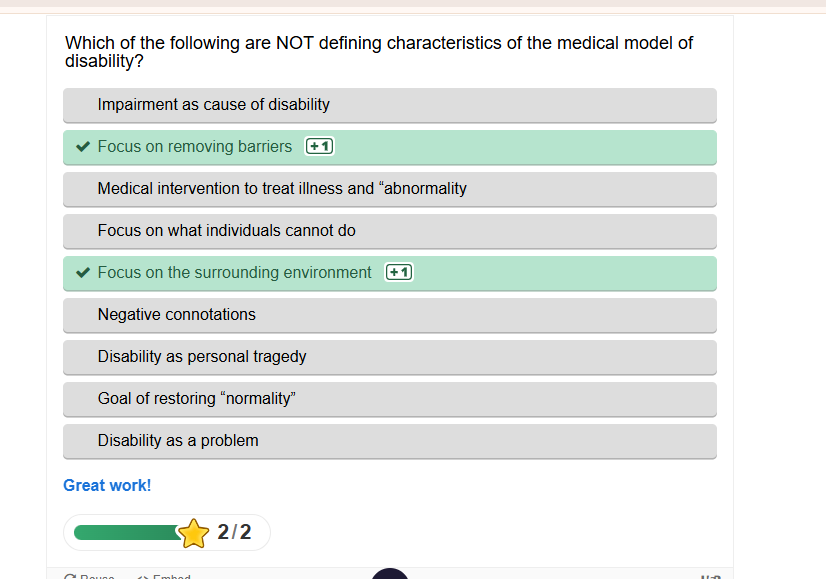
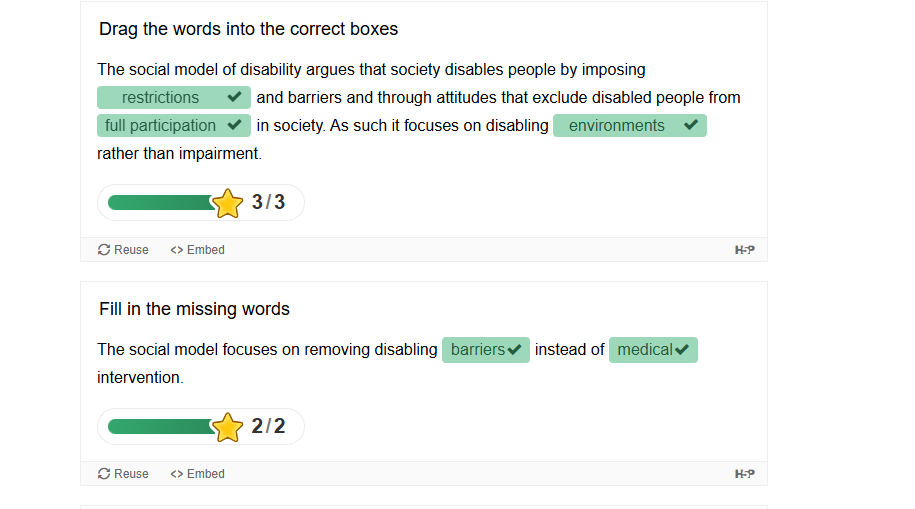
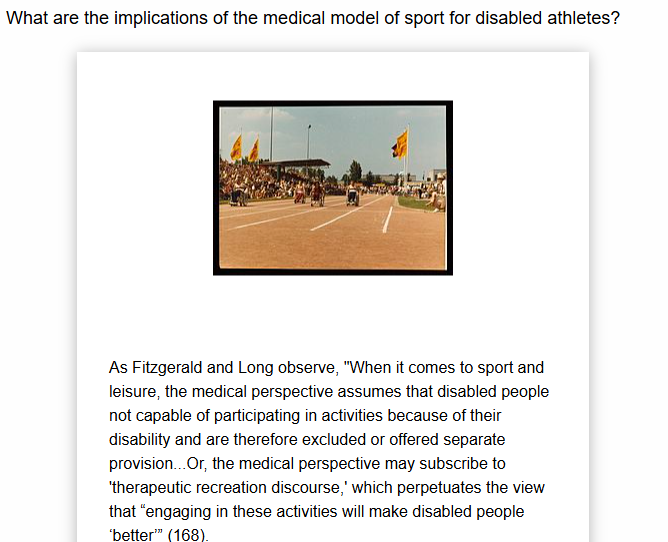
Exercise 5: Notebook Prompt
What do Fitzgerald and Long identify as barriers to inclusion and how might these apply to sport in particular?
Fitzgerald and Long discuss the challenges of both separate and integrated sport and leisure options for disabled people. Separate provision can be a problem because some disabled individuals, like those in the deaf community, don’t see themselves as “disabled” and may not want to take part in activities specifically for disabled people. Others may prefer separate activities because they feel more comfortable with people who have similar abilities. However, it’s often hard to gather enough people for separate teams, and it may require traveling long distances. This can also make mainstream sports organizations feel they don’t need to include disabled people, which keeps the divide between disability and regular sports.
Integrated provision has its own challenges too. Disabled people might feel insecure or afraid of being humiliated when participating with non-disabled people, especially if they can’t keep up. Some non-disabled people might also feel uncomfortable or frustrated if disabled participants don’t perform as expected. Whether integration works also depends on the type of disability, as people with severe learning disabilities or communication challenges may face more barriers.
Reverse integration, where non-disabled people join activities traditionally for disabled people, can help reduce the divide by allowing disabled individuals to be the experts. This can make disabled people feel empowered and challenge stereotypes, promoting inclusivity in sport and leisure.
C) Inclusion, Integration, Separation
Exercise 6: Complete the Activities
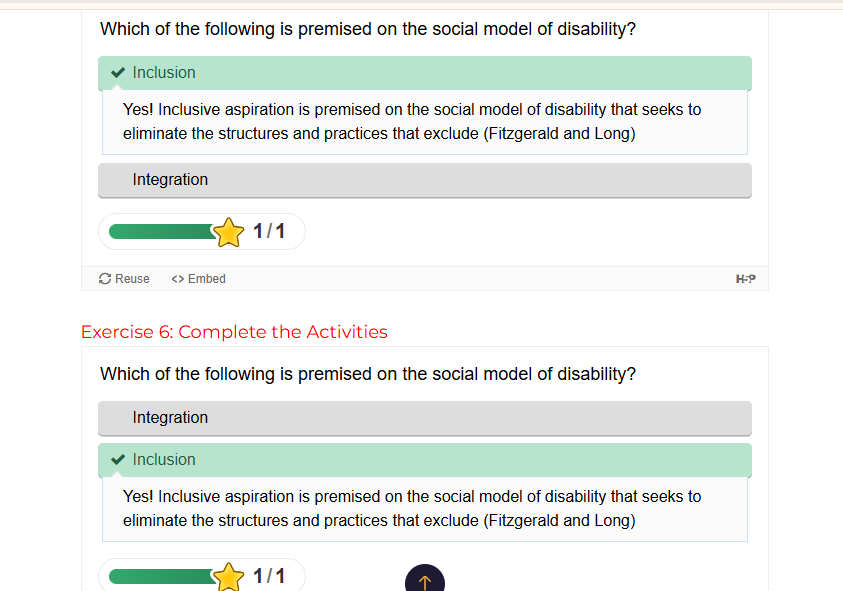
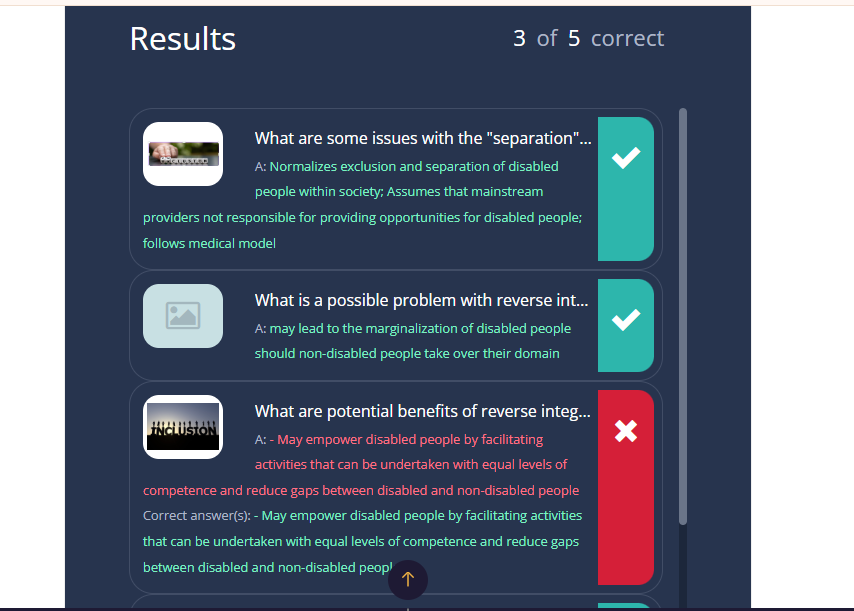
None of my answers seemed correct, so I decided to type in the “exact” correct answer, but it turns out some of those were wrong too.
Exercise 7: Notebook Prompt
Choose ONE of the three questions Fitzgerald and Long argue disability sport needs to address and record your thoughts in your Notebook.
- Should sport be grouped by ability or disability?
- Is sport for participation or competition?
- Should sport competitions be integrated?
Based on their article I think sports should not be grouped by either ability or disability alone. Fitzgerald and Long suggest that a combination of approaches is needed to accommodate the diverse needs of disabled individuals. This could include integration, where disabled and non-disabled people participate together, reverse integration, where non-disabled people join disability sports, and separate provision when necessary. The goal is to create a variety of opportunities where disabled people can participate in ways that work for them, rather than strictly grouping by ability or disability. The key is offering choices that allow individuals to engage in sport and leisure on their own terms, without being restricted by one model.
|
Part Two: Making Connections
A) Gender, Sport and Disability

Exercise 8: Complete the Activity
The paradox that sportswomen habitually face (as the authors observe, this isn’t confined to disabled sportswomen) involves the expectation they will be successful in a ‘masculine’ environment while complying with femininity norms in order to be recognized as a woman.
True or false?
Take a moment to reflect on this paradox below (optional).
| True. The paradox sportswomen face is that they are expected to be successful in sports, which are often seen as “masculine,” but also need to meet feminine expectations, like being graceful or attractive, to be recognized as women. This creates a difficult balance, as they have to prove their athletic ability while also conforming to gender norms. It shows how limiting these expectations can be and emphasizes the need for a broader view of femininity in sports, where women can succeed without being forced into contradictory standards.
|
B) Masculinity, Disability, and Murderball
Exercise 9: Notebook/Padlet Prompt
Watch the film, Murderball and respond to the question in the padlet below (you will have an opportunity to return to the film at the end of this module).
The authors of “Cripping Sport and Physical Activity: An Intersectional Approach to Gender and Disability” observe that the “gendered performance of the wheelchair rugby players can…be interpreted as a form of resistance to marginalized masculinity” (332) but also point out that it may reinforce “ableist norms of masculinity.” After viewing the film, which argument do you agree with?
a) Murderball celebrates a kind of resistance to marginalized masculinity
| After watching Murderball, I think the film does (d) both of these things. On one hand, the film shows athletes like Mark Zupan and Joe Soares who push back against the idea that men with disabilities are fragile and incapable of doing sports. In the documentary, they are seen as tough, aggressive, and really competitive, which challenges the stereotypical view of “marginalized masculinity” that often surrounds people with disabilities. Instead of being seen as weak, these athletes display strength and resilience, which can be seen as a form of resistance. They are showing that people with disabilities can be powerful and strong, just like able-bodied athletes. On the other hand, the film also leans into some traditional ideas of masculinity. The sport itself is very physical, focused on aggression and strength, which often aligns with the dominant cultural ideas of what it means to be a “real” man. Even though the athletes are disabled, the emphasis is still on physical toughness and the ability to dominate, which can reinforce ableist norms that link masculinity to physical power. So, in the end, Murderball does both things, it challenges marginalized masculinity by showcasing the power and strength of disabled athletes, while also reinforcing ableist and traditional masculine ideals centered around physicality and dominance.
|
Section Three: Taking a Shot
A) Resistance
B) Calling out Supercrip
Exercise 10: Mini Assignment (worth 5% in addition to the module grade)
1) Do you agree with the critique of the “supercrip” narrative in this video? Why or why not? Find an example of the “supercrip” Paralympian in the 2024 Paris Paralympics or Special Olympics coverage and explain how it works.
|
|
2) Does the film Murderball play into the supercrip narrative in your opinion? How does gender inform supercrip (read this blog for some ideas)?
(300 words for each response)
| I think Murderball does lean into the “supercrip” narrative to some extent. The film presents the athletes as extraordinary, but a lot of that comes from how they push past their disabilities. While it does show their toughness and skill in wheelchair rugby, it also suggests that their value is tied to overcoming physical limitations. Their athleticism is framed as impressive because of their disabilities, which reinforces the idea that disabled people are only seen as truly “extraordinary” when they defy expectations. The film portrays these athletes as heroes and not just for excelling in their sport, but for overcoming physical challenges that society often views as weaknesses. This can contribute to the idea that disabled people need to be “superhuman” to be respected (like I mentioned in the first question). It also puts pressure on others with disabilities, as if the only way to be valued is by achieving something extraordinary. In doing so, the film risks overlooking the broader, more varied experiences of people with disabilities.
Gender plays a key role in this narrative too. In Murderball, the athletes are all men, and their stories align with traditional, hyper-masculine ideals (strength, aggression, and dominance). The film emphasizes their physicality and competitive nature, which ties into the idea that disabled men must prove they are “real” men by being tough and dominant, even in the face of their disability. This reinforces gendered expectations of masculinity, where men are supposed to be self-reliant, strong, and heroic. In his blog “I Am Not Your Supercrip,” Ben Mattlin critiques the “supercrip” narrative by pointing out that it can make disabled people feel like they have to achieve extraordinary feats to be seen as worthy of attention or respect. This can overshadow the everyday reality of living with a disability. Murderball celebrates these athletes, but it also reinforces the idea that their value comes from being exceptional, which ties into gender expectations about what men, especially disabled men, should be able to do.
|

